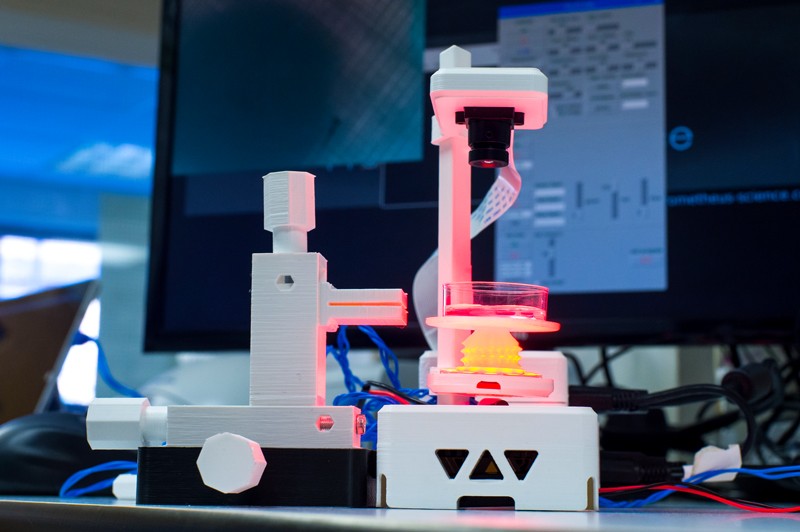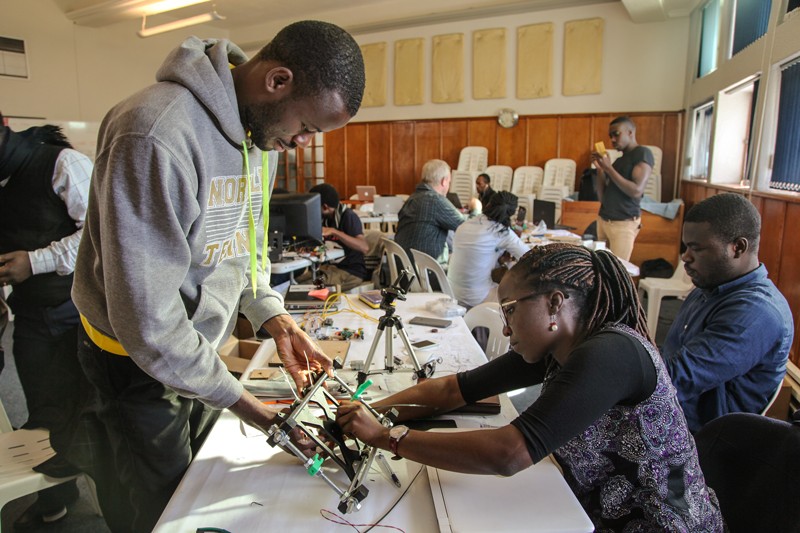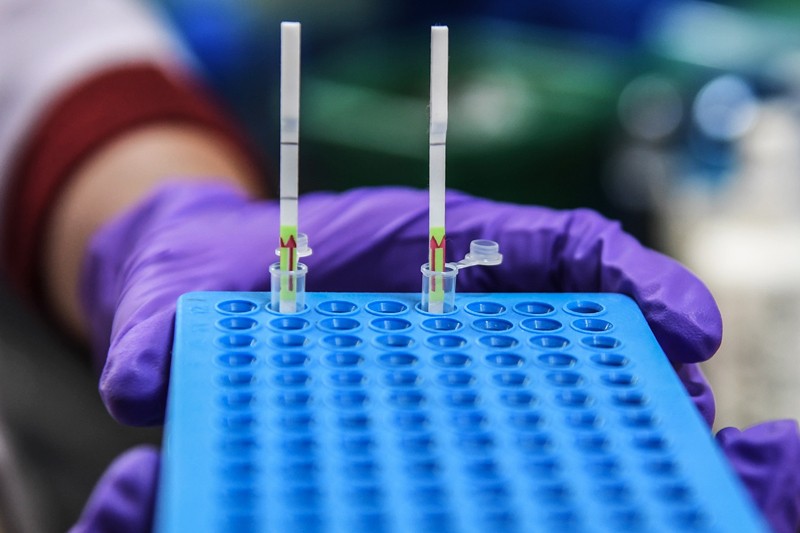Eyes trained on the cells under his microscope, Gustavo Batista Menezes had more on his mind than just science.
Menezes was using a specialized confocal microscope at the University of Calgary, Canada, that cost nearly one million dollars, and he had no idea how he would afford one when he returned home to Brazil to start his own lab. “It’s almost impossible to have that amount of money in low-income countries,” says Menezes. So, when he got a position in 2009 at the Federal University of Minas Gerais in Belo Horizonte, he opted not to buy a fancy commercial instrument; he jury-rigged his own.
Menezes uses microscopy to visualize cells in live mice. Modifying existing microscopes to do this ‘intravital’ imaging typically costs US$5,000–10,000. But Menezes found a cheaper way: he pooled funds with colleagues and bought a cheap, bare-bones confocal microscope, a $1 plexiglass stage and a $2 infrared lamp from a local hardware store. “Twelve minutes after the microscope was installed in my lab,” he says, it produced its first in vivo images. It would go on to generate images that were good enough to twice make the cover of the journal Hepatology.
“The idea that scientists build their own equipment is as old as science,” says Tom Baden, a neuroscientist at the University of Sussex near Brighton, UK, who co-founded a non-profit organization known as Teaching and Research in Natural Sciences for Development (TReND) in Africa, which, among other things, provides training in open-science hardware. What’s new is the online availability of a vast array of free open-source designs, and the growing ease of building them using 3D printers and hobbyist electronics such as Arduino and Raspberry Pi. Coupled with open-source reagents, these resources are making advanced diagnostics accessible even in resource-poor regions that lack trained technicians, cold storage and reliable power.
Building your own instruments — and synthesizing your own reagents — can be time-consuming and labour-intensive. It can yield materials that are more finicky and less reliable than commercial alternatives. And you’re on your own when it comes to technical support. Still, for those willing to stick it out, the result can be transformative. Menezes has shared his low-cost design1 with labs all over Brazil, including in some of the poorest parts of the country, where he says the professors had never before used a confocal microscope. “These technologies should be available to every single person that wants to do research,” he says.
Democratizing science
For some researchers, the allure of do-it-yourself research is the DIY itself: building and maintaining bespoke equipment is an engineering and technical challenge. But for others, it’s a financial matter. Homemade equipment tends to be substantially less expensive — and therefore more accessible — than commercial alternatives.
Thomas Mboa, founder of MboaLab, a collaborative space that provides training and resources for open science in Yaoundé, Cameroon, recalls that he didn’t get to even touch a microscope when he was studying molecular biology at the University of Yaoundé I. “I just had the theoretical knowledge, and the explanation they gave us at that time was that the equipment is very expensive,” he says. “Open science and DIY biology can fix the technological gap we are facing in Africa.”
Using freely available designs, researchers can build everything from pipettes and incubators to polymerase chain reaction (PCR) machines for amplifying DNA. Joshua Pearce, a materials engineer at Michigan Technological University in Houghton who has written a book about building open-source hardware in science, estimates that he’s saved hundreds of thousands of dollars by building his own lab equipment. “We basically don’t buy stuff any more,” he says. Hardware built from open-source designs generally costs just 1–10% of the price of commercial counterparts, says Pearce, and he has curated many of the designs on his website, Open-Source Lab.
“Hardware is the last barrier that we need to break before science really becomes more widely available,” says University of Sussex research bioengineer Andre Maia Chagas. Chagas has started a database, called Open Neuroscience, that people can use to share their projects, and he provides advice to TReND in Africa. Open hardware, he says, can help to democratize research in places such as India, Brazil and across Africa. “Now groups in all these countries can build things themselves and bring themselves to the same playing field,” he says.
Fernan Federici is a case in point. Instead of buying an off-the-shelf fluorescent microscope for $25,000 or more, Federici, a molecular biologist at the Catholic University of Chile in Santiago, 3D-printed his own for just $250. It can’t do everything that a brand-name instrument can, but it does enough. “We needed a specific application — getting fluorescent time-lapses of bacteria growing — and we could do it with open hardware,” he says.
Another advantage of DIY hardware is customizability. The 3D-printable OpenFlexure microscope2, for instance, “was designed for labs in the UK that currently buy an expensive commercial microscope and then take a chisel to it, to customize the optics”, says Richard Bowman, a physicist at the University of Bath, UK, who started the project. A fully automated lab-grade OpenFlexure microscope with a digital camera, motorized sample stage and focus control can cost as little as £200 (US$262). Researchers have customized the base design with optics and lasers suitable for applications such as super-resolution microscopy, but the low cost and power requirements and the convenient portability of the microscope have also made it invaluable in resource-poor regions of Tanzania, where it’s being used to diagnose malaria.
Building your own equipment does mean doing without a warranty and tech support when something breaks. But that can actually be an advantage. Menezes says he’s usually better off repairing his own equipment: maintenance contracts are expensive, and it can take months for a technician to show up. Similarly, says Bowman, “by building the OpenFlexure microscope in Tanzania, we make sure that when it breaks, there’s someone local who’s able to fix it”.
DIY reagents
Jenny Molloy, a biotechnologist at the University of Cambridge, UK, is working to address another financial barrier to research. Recognizing that reagents often represent a significant hurdle to molecular-biology research in resource-poor regions, Molloy founded the Open Bioeconomy Lab, an interdisciplinary group that develops open-source tools for biotechnology. Since 2017, she has compiled 84 open-source enzymes and 45 reporter genes, including polymerases, ligases, reverse transcriptases, restriction enzymes and fluorescent proteins, in the Open Enzyme Collection. “We estimate that you can save at least 80–90% of the cost of an enzyme by producing your own,” she says.
Researchers can order research-grade reagents in the Open Enzyme Collection from the FreeGenes online catalogue as DNA components for cloning into expression vectors and expressing in bacteria to produce their own enzymes. Molloy is now developing ready-to-express plasmids that she can distribute through the non-profit repository Addgene. She is also working with Mboa to manufacture and sell low-cost, ready-to-use enzymes in Cameroon through the Yaoundé-based non-profit enterprise Beneficial Bio, with collaborations in other countries in the planning stage.
In many cases, Molloy says, the Open Enzyme Collection provides access to better reagents than researchers might otherwise be able to afford. The enzyme Taq polymerase, for instance, is a popular choice for PCR not because it’s necessarily the best, but because it’s inexpensive, she says. “Our keystone enzyme at the minute is OpenVent, and it’s much more thermostable and robust than Taq and has five-times higher fidelity.”
That said, labs that choose to DIY their own reagents have to be prepared to do their own enzyme expression, purification and testing. Molloy, who has run open-enzyme manufacturing courses in Ghana and Ethiopia, with others planned across Africa and South America, says the Open Bioeconomy Lab can provide easy-to-follow protocols for testing enzyme activity and purity. And the group is developing an open-source bioreactor for growing the cells that produce the desired enzymes. However, she says, “if you are not a protein expert, definitely reach out to other biologists who might be able to help you”.
Affordable diagnostics
DIY reagents can also reduce the cost of some molecular diagnostics, and Molloy has curated a selection of enzymes that could be applied to health care in resource-poor regions. Yet DIY diagnostics do require special considerations, she says. Devices and reagents have to meet higher standards and follow stringent regulations, while also being more robust and easy-to-use in a health-care setting.
To use the OpenFlexure microscope to diagnose malaria in Tanzania, for example, Bowman had to take loosely strewn electronic boards and cables from his lab set-up and present them in a user-friendly package. “Going from something that works in my lab, where we’re used to dealing with that kind of naked hardware, to having something that doesn’t freak out the parasitology technicians is quite a big step,” he says.
The same holds true for molecular assays, says Debojyoti Chakraborty, who heads an RNA biology group at the Institute of Genomics and Integrative Biology in New Delhi. Chakraborty and his colleague Souvik Maiti developed a cheap, portable paper-strip test to identify carriers of sickle-cell disease in rural India. “Things have to be simple; they have to be robust; and they have to be reproducible,” he says. Realizing that drawing blood samples from young children would require no small amount of coaxing, for instance, the pair worked out protocols to use DNA from saliva instead.
That adaptability helped the researchers to quickly repurpose their diagnostic to test for SARS-CoV-2 in early 2020. The resulting assay3,4 is expected to cost just 600 rupees (US$8) and can be performed in any lab with a regular PCR machine, compared with the 2,500–4,000 rupees for the typical advanced test that only specialized institutes can handle.
Similarly, when Navjot Kaur, a PhD student at the Indian Institute of Science in Bangalore, developed a low-cost, point-of-care diagnostic test5 for tuberculosis, she knew it had to be accessible to remote villages that lacked trained technicians, not to mention dependable power. So, she eschewed PCR’s thermal cycling in favour of an alternative that works at a constant temperature, and is working to increase the test’s stability in the absence of refrigerators and freezers. “It’s only when you go out in the field that you realize all these small things that can completely kill your fancy technology,” she says.
With so much technology now readily accessible, the biggest hurdle to wider adoption of DIY devices might actually be psychological. “Many times, there’s this perception that science needs to be very fancy,” says Lucia Prieto-Godino at the Francis Crick Institute in London. She tries to dispel that notion at open-hardware workshops run by TReND in Africa, which she co-founded with Baden and Sadiq Yusuf — although she admits that DIY projects can be daunting for the uninitiated.
Start small and with something that the lab really needs, Chagas advises. Open-science hardware designs are readily available online at the US National Institutes of Health 3D Print Exchange and the Public Library of Science Open Source Toolkit.
Also readily available is help,whether it’s online at such sites as Gathering for Open Science Hardware (GOSH) and the Africa Open Science and Hardware network (AfricaOSH), through your university’s engineering department or in local open-hardware communities such as Makerspaces and FabLabs. Such resources can quickly bridge gaps in skills and knowledge, Federici says. “We are able to put together a device that helps us to do fluorescence research without being an expert on any of these topics like fluorescence, engineering or electronics,” he says.
3D revolution
Many projects require 3D printing, which has transformed DIY science. “The fact that if you can dream of anything, you go to your garage and then start printing it out, it’s so empowering,” says Jephias Gwamuri, director of research and innovation at Great Zimbabwe University in Masvingo. He has been using 3D printers to print low-cost face shields, personal protective equipment and ventilator parts during the COVID-19 pandemic.
Decent 3D printers are now available for as little as $250, and generally come preassembled. However, as with PCR instruments, limited access to 3D printers and a lack of reliable electricity to run them remain barriers to DIY science.
Gwamuri is trying to rectify the power problem by designing solar-powered 3D printers that are small enough to fit in a duffel bag for transport to remote sites. He and Pearce have also worked to reduce the cost of filament used in 3D printers. Commercial filament costs $20 per kilogram, but Gwamuri found a way to make filament from recycled plastic waste that costs just $1–4 per kilogram, he says.
Researchers can also cut costs by recycling lab equipment, for instance from old or broken microscopes. “The most likely component to be able to reuse is the objective lens, which is also one of the most expensive and hard-to-source pieces,” says Bowman. Menezes built his own $5 gel imager — a device that normally costs $3,000–5,000 — out of an ultraviolet illuminator he fished out of the rubbish and some black plexiglass with a hole for a phone camera.
Such economy can extend tight budgets, but DIY hardware is of little use if it cannot generate reliable, replicable data. “The reason we use the Raspberry Pi camera is it’s a known quantity,” Bowman says. “It would also be possible to reuse a cheap webcam, but every webcam is slightly different, so you lose consistency.”
“That’s one of the challenges I see with open hardware getting mainstream in research, because the quality of the equipment affects the data you get,” says Victor Kumbol, a neuroscience PhD fellow at the Einstein Center for Neurosciences in Berlin, who built his own device to quantify animal activity during his master’s research at the Kwame Nkrumah University of Science and Technology in Kumasi, Ghana6.
Look for designs that have been published in peer-reviewed journals, such as HardwareX, where Kumbol published his design, or the Journal of Open Hardware. And pick devices with good documentation for construction, calibration and maintenance. In the past few months, for instance, Bowman has added a tool to the OpenFlexure microscope software that walks users through basic calibration steps.
Sometimes, however, DIY just isn’t a good option. “You need to know how precise your tool needs to be for a given task,” says Baden. A lab doing cutting-edge molecular-biology research, for instance, probably won’t want to save money on pipettes at the cost of accuracy, he says. But it might be able to balance costs and accuracy by buying precisely calibrated commercial pipettes for handling a couple of microlitres, and using less-precise 3D-printed ones for larger volumes.
Labs will have to navigate these trade-offs according to their research priorities, DIY experience and budget. But as the accessibility and sophistication of DIY hardware increases, so too will its uptake. “This is going to open up a lot of interesting possibilities,” Chagas says.
"how" - Google News
November 17, 2020 at 06:02PM
https://ift.tt/35DxQnG
How DIY technologies are democratizing science - Nature.com
"how" - Google News
https://ift.tt/2MfXd3I
https://ift.tt/3d8uZUG
Bagikan Berita Ini

















0 Response to "How DIY technologies are democratizing science - Nature.com"
Post a Comment